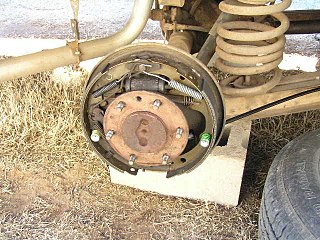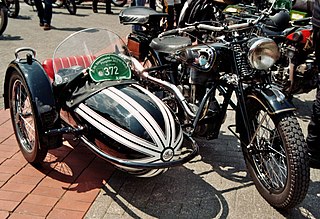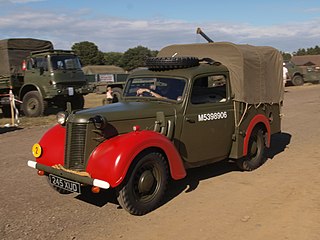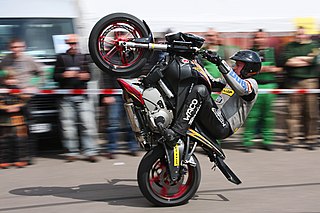
A motorcycle, often called a motorbike, bike, cycle, or trike, is a two- or three-wheeled motor vehicle. Motorcycle design varies greatly to suit a range of different purposes: long-distance travel, commuting, cruising, sport, and off-road riding. Motorcycling is riding a motorcycle and being involved in other related social activity such as joining a motorcycle club and attending motorcycle rallies.

An anti-lock braking system (ABS) is a safety anti-skid braking system used on aircraft and on land vehicles, such as cars, motorcycles, trucks, and buses. ABS operates by preventing the wheels from locking up during braking, thereby maintaining tractive contact with the road surface and allowing the driver to maintain more control over the vehicle.

A drum brake is a brake that uses friction caused by a set of shoes or pads that press outward against a rotating cylinder-shaped part called a brake drum.

A tricycle, sometimes abbreviated to trike, is a human-powered three-wheeled vehicle.

A sidecar is a one-wheeled device attached to the side of a motorcycle, scooter, or bicycle, making the whole a three-wheeled vehicle. A motorcycle with a sidecar is sometimes called a combination, an outfit, a rig or a hack.
Automobile handling and vehicle handling are descriptions of the way a wheeled vehicle responds and reacts to the inputs of a driver, as well as how it moves along a track or road. It is commonly judged by how a vehicle performs particularly during cornering, acceleration, and braking as well as on the vehicle's directional stability when moving in steady state condition.

Countersteering is used by single-track vehicle operators, such as cyclists and motorcyclists, to initiate a turn toward a given direction by momentarily steering counter to the desired direction. To negotiate a turn successfully, the combined center of mass of the rider and the single-track vehicle must first be leaned in the direction of the turn, and steering briefly in the opposite direction causes that lean. The rider's action of countersteering is sometimes referred to as "giving a steering command".

Freestyle BMX is bicycle motocross stunt riding on BMX bikes. It is an extreme sport descended from BMX racing that consists of five disciplines: street, park, vert, trails, and flatland. In June 2017, the International Olympic Committee announced that freestyle park was to be added as an Olympic event to the 2020 Summer Olympics.

Flatland is a freestyle BMX riding style performed on smooth flat surfaces that do not include any ramps, jumps, or grindrails. It is sometimes described as a form of artistic cycling with a blend of breakdancing.

A kickstand is a device on a bicycle or motorcycle that allows the bike to be kept upright without leaning against another object or the aid of a person. A kickstand is usually a piece of metal that flips down from the frame and makes contact with the ground. It is generally located in the middle of the bike or towards the rear. Some touring bicycles have two: one at the rear, and a second in the front.

The six main types of motorcycles are generally recognized as standard, cruiser, touring, sports, off-road, and dual-purpose. Sport touring is sometimes recognized as a seventh category or integrated with the touring category.

Fender is the American English term for the part of an automobile, motorcycle or other vehicle body that frames a wheel well. Its primary purpose is to prevent sand, mud, rocks, liquids, and other road spray from being thrown into the air by the rotating tire. Fenders are typically rigid and can be damaged by contact with the road surface.

Bicycle and motorcycle dynamics is the science of the motion of bicycles and motorcycles and their components, due to the forces acting on them. Dynamics falls under a branch of physics known as classical mechanics. Bike motions of interest include balancing, steering, braking, accelerating, suspension activation, and vibration. The study of these motions began in the late 19th century and continues today.
A motorcycle's suspension serves a dual purpose: contributing to the vehicle's handling and braking, and providing safety and comfort by keeping the vehicle's passengers comfortably isolated from road noise, bumps and vibrations.

Bicycle and motorcycle geometry is the collection of key measurements that define a particular bike configuration. Primary among these are wheelbase, steering axis angle, fork offset, and trail. These parameters have a major influence on how a bike handles.

Motorcycle stunt riding, often referred to as stunting, is a motorcycle sport characterized by stunts involving acrobatic maneuvering of the motorcycle and sometimes the rider. Common maneuvers in stunt riding include wheelies, stoppies, and burnouts. Sport bikes and dirtbikes have become a common vehicle for stunts for its light weight and high power output.
Motorcycle components and systems for a motorcycle are engineered, manufactured, and assembled in order to produce motorcycle models with the desired performance, aesthetics, and cost. The key components of modern motorcycles are presented below.

In vehicle acrobatics, a wheelie, or wheelstand, is a vehicle maneuver in which the front wheel or wheels come off the ground due to sufficient torque being applied to the rear wheel or wheels, or rider motion relative to the vehicle. Wheelies are usually associated with bicycles and motorcycles, but can be done with other vehicles such as cars, especially in drag racing and tractor pulling.

Mountain bike trials, also known as observed trials, is a discipline of mountain biking in which the rider attempts to pass through an obstacle course without setting foot to ground. Derived from motorcycle trials, it originated in Catalonia, Spain as trialsín and is said to have been invented by Pere Pi, the father of Ot Pi, a world champion motorcycle trials rider. Pi's father had wanted his son to learn motorcycle trials by practicing on an ordinary bicycle.
















